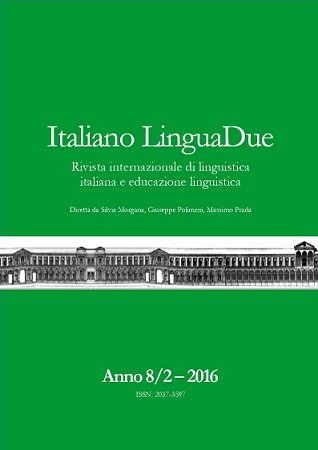SCRITTO E PARLATO, IL PARLATO NELLO SCRITTO. PER UNA DIDATTICA DELLA CONSAPEVOLEZZA DIAMESICA
DOI:
https://doi.org/10.13130/2037-3597/8185Abstract
Oggetto di questo contributo è il rapporto tra scritto e parlato nelle pratiche degli studenti maturi (quelli degli ultimi anni delle superiori e dei primi dell’università) e nella didattica della scuola superiore. La forte discrepanza tra le pratiche quotidiane e il modello frequentemente proposto dalla scuola, insieme ad un addestramento insufficiente alla scrittura progettuale, si risolve spesso in testi manchevoli dal punto di vista della funzionalità comunicativa e della coerenza interna, perché gli studenti non sono in grado di valutare l’adeguatezza di quanto scrivono rispetto al sistema delle attese culturali e linguistiche e tendono a contaminare in maniera casuale caratteri tipici dello scritto e del parlato, elementi delle varietà diafasicamente alte e di quelle trascurate, tratti culti e gergali. Per ridurre le difficoltà degli apprendenti, l’insegnamento della scrittura dovrebbe essere una didattica delle varietà e degli usi della lingua, che abitui i discenti a considerare il sistema di attese dei loro destinatari. A titolo di proposta formativa, l’articolo offre specimina di alcune attività come esercizi raccolti in gruppi funzionali: possono essere svolti in classe, nelle ore di lezione o di laboratorio, o essere assegnati per lo svolgimento indipendente a casa, seguiti da un momento di riflessione e di discussione comune.
Writing and speaking, speech in writing. Teaching diamesic awareness
The subject of this paper is the relationship between written and spoken language in the practices of students in the last years of high school and the first years of college and in secondary school. The strong discrepancy between daily practices and the models frequently proposed by schools, together with insufficient training in project writing, often results in texts that are deficient in terms of communicative function and internal consistency. Students are not able to assess the appropriateness of what they write with respect to linguistic and cultural expectations and they tend to combine, in a random way, characteristics typical of written and spoken language, elements that are highly diaphasic and neglected, idiomatic expressions and slang. To reduce the difficulties of the learners, the teaching of writing should include the varieties and uses of language, and accustom learners to consider the expectations of their audience. The article offers examples of activities and exercises that can be implemented in the classroom, during lectures, in workshops or be assigned as homework, followed by reflection and group discussion.




